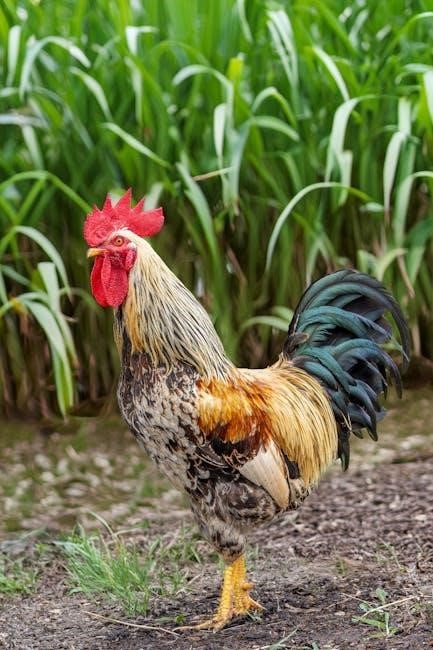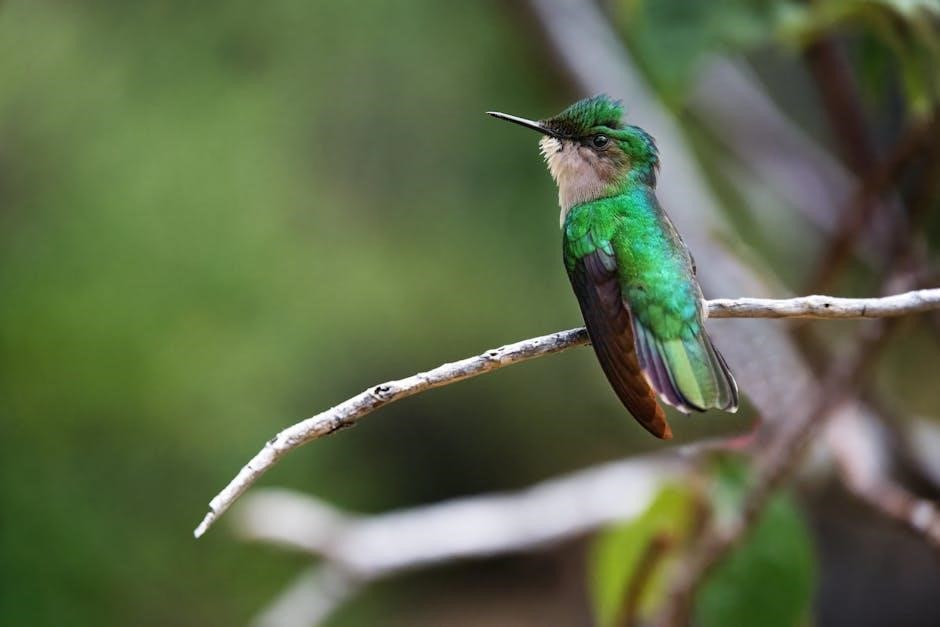Western North America offers a diverse range of bird species, from common residents to rare migrants, attracting enthusiasts with its unique habitats and seasonal variations.

Overview of the AMNH Birds of North America Guide
The AMNH Birds of North America Guide, published by DK, offers comprehensive coverage of over 400 species, featuring detailed photographs, artwork, and audio recordings of bird sounds.
Species Catalog
The AMNH Birds of North America Guide features a detailed species catalog profiling over 400 bird species in Western North America. Each species is represented with stunning photographs and artwork, showcasing plumage variations, subspecies, and flight patterns. The catalog includes both common and rare birds, providing essential information for identification. Full-page profiles highlight key characteristics, such as plumage differences, similar species comparisons, and distinctive behaviors. Rare and vagrant birds are also covered, ensuring the guide is comprehensive for birders of all levels. This catalog serves as a vital resource for understanding the avifauna of the region, making it indispensable for field identification and research.
Rare and Vagrant Birds
The AMNH Birds of North America Guide dedicates significant attention to rare and vagrant birds, providing detailed descriptions and images of these elusive species. These birds, which occasionally stray into Western North America, are often challenging to identify due to their infrequent appearances. The guide includes range maps and sighting records, helping birders track these unusual visitors. Full-page profiles offer insights into their plumage, behaviors, and distinguishing features, making identification more accessible. This section is particularly valuable for experienced birders seeking to expand their knowledge and spot rare species. By including these birds, the guide underscores its commitment to comprehensiveness, ensuring it remains a trusted resource for enthusiasts and researchers alike.
Importance of the Guide
The AMNH Birds of North America Guide is an indispensable resource for birders, offering detailed profiles of over 400 species in Western North America. Its comprehensive coverage, including rare birds, makes it a vital tool for both beginners and experienced enthusiasts. The guide’s combination of stunning photographs, annotated artworks, and audio recordings of bird sounds enhances identification accuracy. Its portability and user-friendly design allow birders to carry it effortlessly into the field. By providing essential information on plumage variations, habitats, and behaviors, the guide bridges the gap between observation and understanding. This makes it a cornerstone for anyone passionate about birdwatching, ensuring a deeper connection with the region’s avifauna.

Kaufman Field Guide to Birds of North America
A user-friendly guide covering over 600 species, with detailed range maps and clear information, making it a portable and essential tool for birders of all levels.
Approach and Features
The Kaufman Field Guide to Birds of North America employs a user-friendly approach, organizing species by shape and behavior for easier identification. It features detailed range maps, seasonal variations, and plumage differences, making it a comprehensive tool for birders. The guide covers over 600 species, including migrants and vagrants, with clear descriptions and comparisons to similar birds. Its compact size and portability enhance its practicality for field use. The guide also emphasizes habitat preferences and vocalizations, providing a well-rounded resource for both novice and experienced birdwatchers. By focusing on clarity and accessibility, the Kaufman Field Guide has become a trusted companion for exploring North America’s avifauna.
Coverage and Updates
The Kaufman Field Guide to Birds of North America provides extensive coverage of over 600 species, including migrants, residents, and vagrants. It incorporates detailed range maps, seasonal variations, and plumage differences, ensuring accuracy for birders across diverse regions. Regular updates, such as the 2005 edition, reflect the latest taxonomic changes and distribution data. The guide collaborates with regional experts to refine its content, making it a reliable resource for both eastern and western North America. Its comprehensive approach ensures that even rare species are well-documented, while its user-friendly design keeps it accessible for all skill levels. By staying current with avian research, the Kaufman Field Guide remains a vital tool for birdwatching enthusiasts.
Smithsonian Handbooks: Birds of North America
Published in collaboration with the Smithsonian Institution, these handbooks feature a photographically-rich design, covering both Eastern and Western regions with detailed species profiles and annotated images.
Eastern vs. Western Editions
The Smithsonian Handbooks are divided into Eastern and Western editions to cater to the distinct bird populations of North America. The Western edition focuses on species found west of the 100th meridian, including the Rocky Mountains and Pacific regions, while the Eastern edition covers the remainder of the continent. Each edition is tailored to its region, ensuring detailed coverage of local species. The Western edition, for instance, includes 696 species known to breed in its area, making it an indispensable resource for birders in western regions. This regional split allows for more precise identification and highlights the unique avifauna of each area, enhancing the overall birding experience for enthusiasts.
Key Features
The Smithsonian Handbooks: Birds of North America series excels with its detailed species profiles, annotated photographs, and artwork. Each full-page profile combines precise descriptions, annotated images, and illustrations to highlight key field marks, ensuring accurate identification. The Western edition covers 696 species, focusing on birds breeding west of the 100th meridian. Similar species are shown side-by-side, with distinguishing characteristics noted. This design helps birders avoid confusion and makes identification more straightforward. The guide’s regional focus ensures relevance for Western North America, making it an essential tool for both novice and experienced birders. Its comprehensive coverage and user-friendly layout set it apart as a trusted resource for birdwatching in the region.
Sibley Field Guide to Birds of Western North America
Featuring over 652 updated maps, this guide covers winter, summer, year-round, migration, and rare ranges, providing detailed insights into Western North America’s avifauna with expert precision.
Detailed Maps and Updates
The Sibley Field Guide to Birds of Western North America features over 652 detailed maps, contributed by 110 regional experts, showcasing winter, summer, year-round, migration, and rare ranges. These maps provide precise information on species distribution, helping birders track birds across Western North America. Regular updates ensure the guide remains current, reflecting the latest research and sightings. The inclusion of rare and vagrant species adds depth, making it indispensable for both casual and dedicated birdwatchers. The maps are complemented by textual descriptions, offering a comprehensive understanding of bird movements and habitats. This attention to detail makes the Sibley guide a trusted resource for identifying and locating birds in the region.
Unique Features
The Sibley Field Guide to Birds of Western North America stands out for its exceptional illustrations and comprehensive coverage. It includes detailed depictions of birds in various plumages, behaviors, and flight patterns, aiding precise identification. The guide also incorporates range maps that highlight seasonal and migratory movements, offering a visual understanding of bird distribution. Additionally, it covers both common and rare species, making it a valuable resource for birders of all skill levels. The guide’s user-friendly design and thorough updates ensure it remains a top choice for enthusiasts seeking to explore Western North America’s avifauna. Its unique combination of artistry and scientific accuracy makes it an indispensable tool for birdwatching adventures.
National Audubon Society Field Guide
The National Audubon Society Field Guide provides comprehensive coverage of Western North America’s birds, featuring range maps, flight silhouettes, and detailed sections on bird-watching and endangered species.
Comprehensive Coverage
The National Audubon Society Field Guide offers extensive coverage of Western North America’s avifauna, detailing over 700 species with precise range maps and flight silhouettes.
It includes sections on accidental species, endangered birds, and bird-watching tips, making it an indispensable resource for both novice and experienced birders.
The guide’s portability and user-friendly design ensure it is a must-have for anyone exploring the region’s rich birdlife.

Special Features
The National Audubon Society Field Guide stands out with its inclusion of overhead flight silhouettes, enabling quick identification of birds in motion.
It also features detailed range maps, highlighting both breeding and migratory patterns, as well as sections dedicated to accidental species and endangered birds.
Additional resources, such as tips for bird-watching and insights into seasonal variations, enhance the guide’s utility for enthusiasts of all levels.
Its compact design and comprehensive coverage make it an essential companion for exploring Western North America’s diverse avifauna.

Golden Field Guides
The Golden Field Guides cover over 530 species in Western North America, using photographic identification and detailed range maps for accurate bird recognition.
Photographic Identification

The Golden Field Guides utilize high-quality photographs to aid in identifying over 530 bird species in Western North America. Each species is represented with images showcasing plumage variations, including breeding, non-breeding, and juvenile stages. Flight patterns and behavioral traits are also captured, providing visual cues for accurate identification. The guide incorporates range maps alongside photographs, allowing users to correlate a bird’s appearance with its geographic distribution. This photographic approach, combined with concise descriptions, makes it an invaluable tool for both novice and experienced birders. The guide’s slightly larger size compared to others ensures detailed images without compromising portability, making it a comprehensive resource for field use.
Size and Portability
The Golden Field Guides are designed with portability in mind, offering a balance between detailed content and ease of carry. While slightly larger than some field guides, such as the National Geographic Society’s, they remain compact enough to fit into a backpack or bag. This ensures that birders can easily transport the guide while exploring diverse habitats. The guide’s size accommodates high-quality images and range maps without compromising on portability, making it a practical choice for field use. Additionally, a pocket-sized edition is available for those who prefer an even more compact option, further enhancing its accessibility for birdwatchers on the go.

Bird Identification Techniques
Bird identification relies on observing plumage, behavior, and habitat. The guide aids by highlighting distinguishing features, ensuring accurate species recognition in Western North America’s diverse birding environments.
Plumage and Markings
Plumage and markings are critical for identifying bird species. The AMNH guide provides detailed images of plumage variations, including subspecies and seasonal changes, helping birders distinguish similar species. Artwork depicting birds in flight reveals outstretched wings, showcasing key field marks. Rare birds and vagrants are also included, with descriptions of their unique plumage features. The guide’s full-page profiles highlight distinguishing characteristics, such as beak shape, feather patterns, and coloration. This comprehensive approach ensures accurate identification, even for novice birders. Additionally, the guide includes audio recordings of bird sounds, enhancing the identification process beyond visual cues. By focusing on plumage and markings, the guide equips birders with essential tools for recognizing Western North America’s diverse avifauna.
Behavior and Habitat
Understanding bird behavior and habitat is essential for effective birdwatching. The AMNH guide provides detailed insights into the ecological preferences of Western North America’s birds, such as their favored habitats, from dense forests to open grasslands. It also highlights behavioral traits, including feeding patterns, migration routes, and social interactions. This information helps birders locate species more efficiently. For example, knowing that certain warblers prefer riparian zones or that raptors frequent open skies can enhance observation success. The guide further emphasizes how habitat loss and climate change impact bird populations, stressing conservation needs. By linking behavior and habitat, the guide offers a holistic approach to bird identification and appreciation, making it invaluable for both beginners and experienced birders in the region. This focus ensures a deeper connection with the natural world.
Birding Hotspots in Western North America
Western North America boasts diverse birding hotspots, including the Rocky Mountain range, Pacific Coast, and desert regions, attracting a wide variety of species and enthusiasts alike.

Key Regions
Western North America is home to several key birding regions, each offering unique habitats and species diversity. The Rocky Mountain range provides high-altitude nesting grounds for species like the White-tailed Ptarmigan, while the Pacific Coast serves as a critical migratory corridor for shorebirds and waterfowl. Desert regions, such as the Sonoran and Mojave Deserts, host specialized birds like the Cactus Wren and Verdin. Coastal wetlands and estuaries attract herons, egrets, and migratory songbirds, making them hotspots for birders. Additionally, the region’s vast forests, including coniferous and riparian areas, support a wide range of woodpeckers, owls, and warblers. These diverse ecosystems make Western North America a paradise for birdwatching enthusiasts, offering opportunities to spot over 700 species throughout the year.
Seasonal Variations
Western North America experiences distinct seasonal variations that significantly impact bird populations and behaviors. Spring brings migratory songbirds like warblers, tanagers, and orioles, while summer attracts breeding species such as hummingbirds and raptors. Fall migration sees shorebirds and waterfowl moving through coastal and wetland areas, with species like sandpipers and ducks abundant during this time. Winter months draw waterfowl and sparrows to lower elevations, while year-round residents like woodpeckers and owls remain active. These seasonal shifts create dynamic birding opportunities, with each time of year offering unique sightings. Understanding these patterns enhances the birdwatching experience, allowing enthusiasts to anticipate and locate species more effectively across the region’s diverse habitats.

Conservation Efforts in Western North America
Conservation efforts focus on protecting habitats, reducing pollution, and educating the public to safeguard bird populations, ensuring sustainable ecosystems for future generations.
Threats to Bird Populations
Bird populations in Western North America face numerous threats, including habitat loss due to urbanization and agriculture, climate change altering ecosystems, and pollution from pesticides and plastics. Invasive species also disrupt native bird habitats, competing for resources and introducing diseases. Additionally, human activities like deforestation and mining degrade critical nesting and feeding grounds. Climate-driven shifts in weather patterns further threaten migratory routes and food availability. These challenges highlight the urgent need for conservation efforts to protect vulnerable species and their habitats, ensuring the survival of Western North America’s avifauna for future generations.
Role of Field Guides
Field guides play a crucial role in birdwatching by providing detailed information on species identification, habitats, and behaviors. They serve as essential tools for both novice and experienced birders, offering high-quality images, maps, and descriptions to aid in accurate identification. Guides like the AMNH Birds of North America and Kaufman Field Guide include comprehensive species catalogs, rare bird descriptions, and updated range maps, making them indispensable for understanding avifauna. These resources also promote conservation by raising awareness of threatened species and their habitats; By equipping birders with knowledge, field guides foster a deeper appreciation for birds and their ecosystems, encouraging responsible birding practices and supporting efforts to protect biodiversity in Western North America.

Birdwatching in Western North America is enriched by the wealth of field guides available, such as the AMNH Birds of North America and Kaufman Field Guide. These resources provide detailed species profiles, updated maps, and photographic identification, empowering birders to explore and understand the region’s avifauna. By highlighting rare species, seasonal variations, and conservation needs, these guides not only aid in identification but also foster a deeper appreciation for birds and their habitats. Their portability and comprehensive coverage make them indispensable tools for enthusiasts and researchers alike, ensuring that birdwatching remains a vibrant and educational pursuit in Western North America for generations to come.
